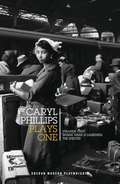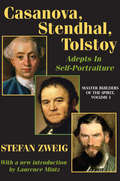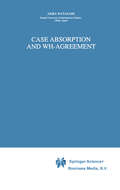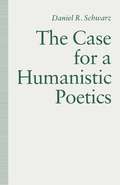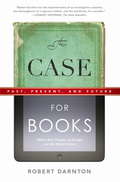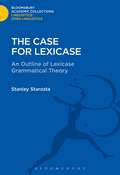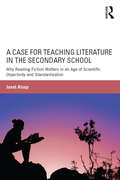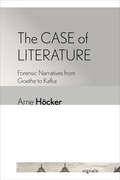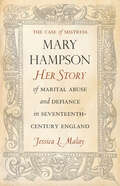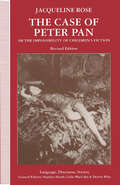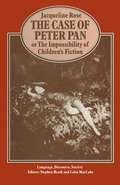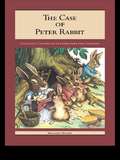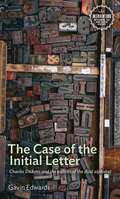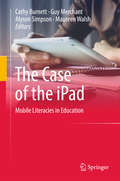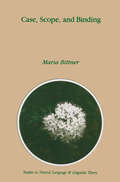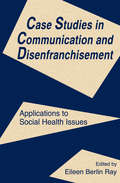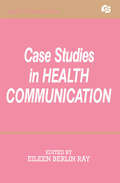- Table View
- List View
Caryl Phillips: Strange Fruit / Where There is Darkness / The Shelter (Oberon Modern Plays)
by Caryl PhillipsThree plays by playwright and novelist Caryl Phillips, written in the 1980s and collected here for the first time. Strange Fruit is a powerful study of a black family caught between two cultures; Where There is Darkness examines the plight of a West Indian man, Albert Williams, on the eve of his return to the Caribbean after an absence of twenty-five years; The Shelter alternates between the late eighteenth-century and 1950s London, exploring the relationship between a black man and a white woman.
Casanova, Stendhal, Tolstoy: Volume 3, Master Builders of the Spirit
by Jay KatzCasanova, Stendhal, Tolstoy: Adepts in Self-Portraiture, the final volume of Stefan Zweig's masterful Master Builders of the Spirit trilogy, discloses the smaller version of a writer's own ego. Unconscious though it is, no reality is as important to the writer as the reality of their own life. Giacomo Casanova, Stendhal (Marie-Henri Beyle), and Leo Tolstoy have different approaches to self-portraiture, but Zweig shows that together they symbolize three levels which represent successively ascending gradations of the same creative function.Casanova is depicted as having a primitive gradation; he simply records deeds and happenings, without any attempt to appraise them or to study the deeper working of the self. Stendhal's self-portraiture is depicted as psychological; he observes himself and investigates his own feelings. Tolstoy has the highest level; he describes his own life, records what led him to his own actions, and focuses on self-reflection in a completely unexaggerated manner.At first glance it might seem as if self-portraiture is an artist's easiest task. With no further trouble than a probing of memory and a description of the facts of life, "the truth" is revealed. The history of literature shows that ordinary autobiographers are no more than commonplace witnesses testifying to facts that chance has brought to their knowledge. A practiced artist is needed to discern the innermost happenings of the soul; few who have attempted autobiography have been successful in this difficult task. The present volume expounds the characteristics of these subjectively minded artists, and of autobiography as their typical method of personal expression.
Casanova, Stendhal, Tolstoy: Volume 3, Master Builders of the Spirit
by Jay KatzCasanova, Stendhal, Tolstoy: Adepts in Self-Portraiture, the final volume of Stefan Zweig's masterful Master Builders of the Spirit trilogy, discloses the smaller version of a writer's own ego. Unconscious though it is, no reality is as important to the writer as the reality of their own life. Giacomo Casanova, Stendhal (Marie-Henri Beyle), and Leo Tolstoy have different approaches to self-portraiture, but Zweig shows that together they symbolize three levels which represent successively ascending gradations of the same creative function.Casanova is depicted as having a primitive gradation; he simply records deeds and happenings, without any attempt to appraise them or to study the deeper working of the self. Stendhal's self-portraiture is depicted as psychological; he observes himself and investigates his own feelings. Tolstoy has the highest level; he describes his own life, records what led him to his own actions, and focuses on self-reflection in a completely unexaggerated manner.At first glance it might seem as if self-portraiture is an artist's easiest task. With no further trouble than a probing of memory and a description of the facts of life, "the truth" is revealed. The history of literature shows that ordinary autobiographers are no more than commonplace witnesses testifying to facts that chance has brought to their knowledge. A practiced artist is needed to discern the innermost happenings of the soul; few who have attempted autobiography have been successful in this difficult task. The present volume expounds the characteristics of these subjectively minded artists, and of autobiography as their typical method of personal expression.
Case Absorption and WH-Agreement (Studies in Natural Language and Linguistic Theory #37)
by A. WatanabeThis book is an extensively revised version of the core part of my 1993 MIT doctoral dissertation, which seeks to provide a Minimalist theory of Case absorption and support it through empirical investigation. The central idea pursued is that impoverishment of phrase structure is responsible for Case absorption and that the right theory of Case checking should derive this property. Although the basic line of research on Case absorption and wh-agreement remains the same, this book incorporates a lot of new results. A principied theory of Case checking and Case absorption has been worked out in Chapter 1. Treatment of participial constructions in Chapter 3 and wh agreement in Chapter 4 is far more systematic and comprehensive. Chapter 2 is also streamlined, together with refinements of the analysis of Romanian. The product, I hope, is a more convincing def ense of the strength of the Mi ni mal ist approach. I would like to thank my thesis committee members Ken Haie, Noam Chomsky, and Howard Lasnik, under whose guidance this project started.
Case and Linking in Language Comprehension: Evidence from German (Studies in Theoretical Psycholinguistics #34)
by Markus Bader Josef BayerThe Case For a Humanistic Poetics
by Daniel R. SchwarzAn attempt to define a humanistic and pluralistic ideology of reading which takes recent theory into account. By the same author as "The Humanistic Heritage: Critical Theories on the English Novel from James through Hillis Miller", and "Reading Joyce's `Ulysses'".
The Case for Books: Past, Present, and Future
by Robert DarntonThe era of the printed book is at a crossroad. E-readers are flooding the market, books are available to read on cell phones, and companies such as Google, Amazon, and Apple are competing to command near monopolistic positions as sellers and dispensers of digital information. Already, more books have been scanned and digitized than were housed in the great library in Alexandria. Is the printed book resilient enough to survive the digital revolution, or will it become obsolete? In this lasting collection of essays, Robert Darnton-an intellectual pioneer in the field of this history of the book-lends unique authority to the life, role, and legacy of the book in society.
The Case for Books: Past, Present, and Future
by Robert DarntonThe invention of writing was one of the most important technological, cultural, and sociological breakthroughs in human history. With the printed book, information and ideas could disseminate more widely and effectively than ever before -- and in some cases, affect and redirect the sway of history. Today, nearly one million books are published each year. But is the era of the book as we know it -- a codex of bound pages -- coming to an end? And if it is, should we celebrate its demise and the creation of a democratic digital future, or mourn an irreplaceable loss? The digital age is revolutionizing the information landscape. Already, more books have been scanned and digitized than were housed in the great library in Alexandria, making available millions of texts for a curious reader at the click of a button, and electronic book sales are growing exponentially. Will this revolution in the delivery of information and entertainment make for more transparent and far-reaching dissemination or create a monopolistic stranglehold? In The Case for Books, Robert Darnton, an intellectual pioneer in the field of the history of the book and director of Harvard University's Library, offers an in-depth examination of the book from its earliest beginnings to its shifting role today in popular culture, commerce, and the academy. As an author, editorial advisor, and publishing entrepreneur, Darnton is a unique authority on the life and role of the book in society. This book is a wise work of scholarship -- one that requires readers to carefully consider how the digital revolution will broadly affect the marketplace of ideas.
The Case for Lexicase (Linguistics: Bloomsbury Academic Collections)
by Stanley StarostaStarosta describes the formal properties of lexicase theory and its historical and metatheoretical relations to other current grammatical frameworks. He argues that it is preferable to other grammatical frameworks, as it is constrained enough to have empirical content, simple enough to be tested and applied to enough languages to have a plausible claim to universality. Examples are drawn from English and various Asian, Pacific, Australian, and African languages.
A Case for Teaching Literature in the Secondary School: Why Reading Fiction Matters in an Age of Scientific Objectivity and Standardization
by Janet AlsupTaking a close look at the forces that affect English education in schools—at the ways literature, cognitive science, the privileging of the STEM disciplines, and current educational policies are connected—this timely book counters with a strong argument for the importance of continuing to teach literature in middle and secondary classrooms. The case is made through critical examination of the ongoing "culture wars" between the humanities and the sciences, recent research in cognitive literary studies demonstrating the power of narrative reading, and an analysis of educational trends that have marginalized literature teaching in the U.S., including standards-based and scripted curricula. The book is distinctive in presenting both a synthesis of arguments for literary study in the middle and high school and sample lesson plans from practicing teachers exemplifying how literature can positively influence adolescents’ intellectual, emotional, and social selves.
A Case for Teaching Literature in the Secondary School: Why Reading Fiction Matters in an Age of Scientific Objectivity and Standardization
by Janet AlsupTaking a close look at the forces that affect English education in schools—at the ways literature, cognitive science, the privileging of the STEM disciplines, and current educational policies are connected—this timely book counters with a strong argument for the importance of continuing to teach literature in middle and secondary classrooms. The case is made through critical examination of the ongoing "culture wars" between the humanities and the sciences, recent research in cognitive literary studies demonstrating the power of narrative reading, and an analysis of educational trends that have marginalized literature teaching in the U.S., including standards-based and scripted curricula. The book is distinctive in presenting both a synthesis of arguments for literary study in the middle and high school and sample lesson plans from practicing teachers exemplifying how literature can positively influence adolescents’ intellectual, emotional, and social selves.
The Case of Literature: Forensic Narratives from Goethe to Kafka (Signale: Modern German Letters, Cultures, and Thought)
by Arne HöckerIn The Case of Literature, Arne Höcker offers a radical reassessment of the modern European literary canon. His reinterpretations of Goethe, Schiller, Büchner, Döblin, Musil, and Kafka show how literary and scientific narratives have determined each other over the past three centuries, and he argues that modern literature not only contributed to the development of the human sciences but also established itself as the privileged medium for a modern style of case-based reasoning.The Case of Literature deftly traces the role of narrative fiction in relation to the scientific knowledge of the individual from eighteenth-century psychology and pedagogy to nineteenth-century sexology and criminology to twentieth-century psychoanalysis. Höcker demonstrates how modern authors consciously engaged casuistic forms of writing to arrive at new understandings of literary discourse that correspond to major historical transformations in the function of fiction. He argues for the centrality of literature to changes in the conceptions of psychological knowledge production around 1800; legal responsibility and institutionalized forms of decision-making throughout the nineteenth century; and literature's own realist demands in the early twentieth century.
The Case of Mistress Mary Hampson: Her Story of Marital Abuse and Defiance in Seventeenth-Century England
by Jessica MalayThe centerpiece of The Case of Mistress Mary Hampson is the autobiographical narrative of a 17th-century woman in an abusive and violent marriage. Composed at a time when marital disharmony was in vogue with readers and publishers, it stands out from comparable works, usually single broadsheets. In her own words, Mary recounts various dramatic and stressful episodes from her decades-long marriage to Robert Hampson and her strategies for dealing with it. The harrowing tale contains scenes of physical abuse, mob violence, abandonment, flight, and destitution. It also shows moments of personal courage and interventions on the author's behalf by friends and strangers, some of whom are subject to severe reprisals. Mary wrote her story to come to terms with her situation, to justify her actions, and to cast herself in a virtuous light. The accompanying discussion of her life, drawn from other sources, provides chilling evidence of the vulnerability of seventeenth-century women and the flawed legal mechanisms that were supposed to protect them. Readers are also invited to consider in what ways the self-portrait is accurate and what elements of it may be considered fabrication. Malay's archival efforts have thus rescued a compelling and complicated voice from the past.
The Case of Peter Pan: or The Impossibility of Children's Fiction (Language, Discourse, Society)
by Jacqueline RoseWhat does Peter Pan have to say about our conception of childhood, about how we understand the child's and our own relationship to language, sexuality, and death? What can Peter Pan tell us about the theatrical, literary, and educational institutions of which it is a part? In a new preface written especially for this edition, Rose accounts for some of the new developments since her book's first publication in 1984. She discusses some of Peter Pan's new guises and their implications. From Spielberg's Hook, to the lesbian production of the play at the London Drill Hall in 1991, to debates in the English House of Lords, to a newly claimed status as the icon of a transvestite culture, Peter Pan continues to demonstrate its bizarre renewability as a cultural fetish of our times.
The Case of Peter Pan or the Impossibility of Children's Fiction: Or The Impossibility Of Children's Fiction (Language, Discourse, Society)
by Jacqueline RoseThe Case of Peter Rabbit: Changing Conditions of Literature for Children (Children's Literature and Culture #7)
by Margaret MackeyFirst published in 1998. Routledge is an imprint of Taylor & Francis, an informa company.
The Case of Peter Rabbit: Changing Conditions of Literature for Children (Children's Literature and Culture)
by Margaret MackeyFirst published in 1998. Routledge is an imprint of Taylor & Francis, an informa company.
The Case of the Initial Letter: Charles Dickens and the politics of the dual alphabet (Interventions: Rethinking the Nineteenth Century)
by Gavin EdwardsThe book analyses attempts by Dickens and other nineteenth-century writers to challenge established ways of using the distinction between upper and lower case letters, in the interests of a wider radicalism. It discusses Dickens’s satire - on ‘Shares’ in Our Mutual Friend, on Paul Dombey’s position as the ‘Son’ of Dombey and Son - alongside the proto-modernist typography of suffragist poet Augusta Webster and the work of Marx’s translators transforming German conventions of capitalisation into English under the influence of Dickens and Carlyle. Placing these innovations within the history of the dual alphabet from its invention by Carolingian scribes to its rejection by modernist poets and the Bauhaus printers, the book tracks the dual alphabet through Dickens’s manuscripts, corrected proofs, and the ‘prompt copies’ for his public Readings, highlighting distinct ways in which writing, printing and speech produce meaning.
The Case of the Initial Letter: Charles Dickens and the politics of the dual alphabet (Interventions: Rethinking the Nineteenth Century)
by Gavin EdwardsThe book analyses attempts by Dickens and other nineteenth-century writers to challenge established ways of using the distinction between upper and lower case letters, in the interests of a wider radicalism. It discusses Dickens’s satire - on ‘Shares’ in Our Mutual Friend, on Paul Dombey’s position as the ‘Son’ of Dombey and Son - alongside the proto-modernist typography of suffragist poet Augusta Webster and the work of Marx’s translators transforming German conventions of capitalisation into English under the influence of Dickens and Carlyle. Placing these innovations within the history of the dual alphabet from its invention by Carolingian scribes to its rejection by modernist poets and the Bauhaus printers, the book tracks the dual alphabet through Dickens’s manuscripts, corrected proofs, and the ‘prompt copies’ for his public Readings, highlighting distinct ways in which writing, printing and speech produce meaning.
The Case of the iPad: Mobile Literacies in Education
by Cathy Burnett Guy Merchant Alyson Simpson Maureen WalshThis book brings together an international group of literacy studies scholars who have investigated mobile literacies in a variety of educational settings. Approaching mobility from diverse theoretical perspectives, the book makes a significant contribution to how mobile literacies, and tablets in particular, are being conceptualised in literacy research. The book focuses on tablets, and particularly the iPad, as a prime example of mobile literacies, setting this within the broader context of literacy and mobility.The book provides inspiration and direction for future research in mobile literacies, based upon 16 chapters that investigate the relationship between tablets and literacy in diverse ways. Together they address the complex and multiple forces associated with the distribution of the technologies themselves and the texts they mediate, and consider how apps, adults and children work together as iPads enter the mesh of practices and material arrangements that constitute the institutional setting.
Case, Scope, and Binding (Studies in Natural Language and Linguistic Theory #30)
by M. BittnerCase, Scope, and Binding investigates the relation between syntax and semantics within a framework which combines the syntactic Government-Binding theory with a novel cross-linguistic theory of case and semantics. It is argued that case assignment, agreement, syntactic binding relations, as well as the minimum scopes of operators, are all determined by the relations which hold at the level of s-structure. Cross-linguistic variation with respect to these phenomena is due to corresponding variations at the s-structure level. The minimum scope of an operator cannot exceed its c-command domain at s-structure, but may be reduced by certain semantic mechanisms. The availability of any wider scope option depends on the possibility of movement at LF. The proposed theory is tested in detail against the facts of Inuit (Eskimo-Aleut family), an ergative language with typologically unusual scope and binding relations. For linguists and philosophers interested in syntax, semantics, or the syntax-semantics interface.
Case Studies in Communication and Disenfranchisement: Applications To Social Health Issues
by Eileen Berlin RaySee blurb for Communication and Disenfranchisement. Books will be promoted together.
Case Studies in Communication and Disenfranchisement: Applications To Social Health Issues
by Eileen Berlin RaySee blurb for Communication and Disenfranchisement. Books will be promoted together.
Case Studies in Health Communication: A Case Study Approach (Routledge Communication Series)
by Eileen Berlin RayThis book focuses on the complexities of the communication of health-related messages and information through the use of case studies. The expert contributors to this volume are scholars who, during their research and consulting, grapple with many of the issues of concern to those studying health communication. While several introductory books offer brief case studies to illustrate concepts covered, this book provides in-depth cases that enable more advanced students to apply theory to real situations.
Case Studies in Health Communication (Routledge Communication Series)
by Eileen Berlin RayThis book focuses on the complexities of the communication of health-related messages and information through the use of case studies. The expert contributors to this volume are scholars who, during their research and consulting, grapple with many of the issues of concern to those studying health communication. While several introductory books offer brief case studies to illustrate concepts covered, this book provides in-depth cases that enable more advanced students to apply theory to real situations.
